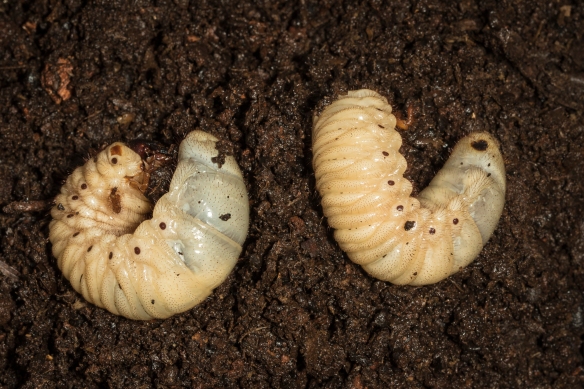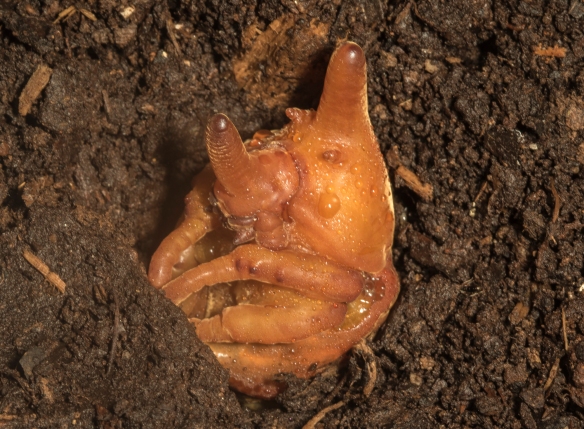You always end up getting involved in things because of, you know, the strange things your life brings you into contact with.
~Edward Norton
I have had a couple of unusual “pets” these past few months. You may recall in an earlier post, I reported on receiving some orphaned Eastern Hercules Beetle grubs one day at work.
A woman brought them in after they were discovered in the hollow of a large tree she had taken down in her yard. She wasn’t sure what they were, but hoped someone at the Garden could tell her and might take them. The front desk volunteer apparently thought, Hmmm, who here would want something like this?…Oh, Mike, he probably would. And that is how I came to have two large grubs in a flower pot of rotten log and topsoil on our screen porch since late March. They are pretty easy pets to take care of – I checked them once or twice a week, spritzing the soil surface each time with a little water to prevent them from drying out. A few times over the summer, I refreshed their rotten log food supply with decayed wood and a couple of apple slices. On several occasions, I showed them to a few house guests (we have tolerant friends) and to visitors during some programs at work. The last time I did this was about two weeks ago for a group of summer camp kids. To do this, I gently poured the soil out into another bucket to reveal the grubs. On the last pour, I noticed one of the grubs had made what looked like a chamber in the soil (it was an impression in the soil about the size of a large chicken egg). I should have known what was about to happen, but it didn’t register at the time.
This past Sunday afternoon, I went out to once again spritz them with water, and when I lifted the lid off the bucket, I was amazed (and a little startled at first) at what I saw…
…and it moved! It’s alive! One of the grubs transformed into a bizarre-looking pupa. This will become a male beetle, as evidenced by the horns, which apparently are quite fragile in the pupal stage. The impression I had seen in the soil a couple of weeks ago was the start of a pupation chamber. The larvae make these one to two weeks prior to pupating. I was probably lucky that my disturbance of the soil had not disrupted this transformation.
The reference I bought talked about this delicate life stage, but did not give information on how long the pupa stage lasts. Another web search found a site that summarized the life stages of the Eastern Hercules Beetle (from the University of Kentucky Critter Files on Eastern Hercules Beetles):
Adult longevity: Typically 3-6 months. The rare adult will live up to a year plus.
Egg-laying to egg hatch: 1 month
Egg hatch to pupation: 12-18 months
Pupation to emergence: 2-3 months, depending on temperature
Emergence of teneral adults to fully-formed adults: About 1 month
I am amazed at the life span of these amazing insects. It looks like I will have these pupae until December or so, when they will emerge as adult beetles. But, they apparently remain in the soil for a month or more while they harden their exoskeleton and change to the adult coloration. Stay tuned. I really want to have one of these giant beetles (with about a 6-inch wing span) flying around the house one day next spring:)



I’m so glad we have you to do these “adventurous” things and report them to us, Mike. Complete with pictures! Not my thing but seriously fascinating. Can’t wait for the pictures of monstrous bugs flying around in your house… 🤣
Thanks, Rich. Maybe I’ll take them on a tour of the hood…
Great idea! Let me know if you need help building the cage.
In high school, I once built a cage large enough to bring in a full-grown rooster — don’t remember why. Not really the best idea I ever had.
They stay grubby underground longer than they are adults having the big life!
Mike, you are a delightfully strange man! LOL!!
Thanks, I think😎
Do they taste like chicken?